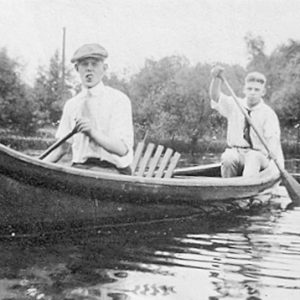calsfoundation@cals.org
Paul Holden Young (1890–1960)
Paul Holden Young was a bamboo fly-rod designer known for making the bamboo fishing rod lighter, shorter, and capable of being broken down so that it could be more easily transported. Today, his rods are collectibles worth many times the prices they sold for in the 1930s and 1940s.
Paul H. Young was born in Cherry Valley (Cross County) on August 27, 1890, to Charles Henry Young and Sarah Alice Young; he had four siblings. His father taught in a variety of local schools but was eventually forbidden from teaching in Cross County after arguments with each school board. Young’s mother, who had several sisters in Jonesboro (Craighead County), raised two of her five children and sent the rest to live with a sister closer to the Jonesboro schools as her husband’s jobs took them farther away. The family frequently lived in shabby rental homes.
As a teenager, Young took any job he could get, and, upon graduating from Jonesboro High School in 1907, taught there for two years. He later attended what is now Arkansas State University, majoring in agriculture, but left in order to help his father convert a local banker’s land into a rice field. However, his father then disappeared, and Young had to get the crops in for two years as part of a bargain that had involved the farm owner giving his mother a house.
Young then traveled around North America, harvesting wheat in Kansas; laboring at a shipyard in Duluth, Minnesota; farming in Saskatchewan, Canada; and engaging in taxidermy in Denver, Colorado, and Detroit, Michigan. In Duluth, he met and married Martha Marie Moisan in 1920; they had two sons, Paul Anthony and Jack.
During his childhood in Arkansas, Young had learned to fish, obtaining fly-fishing gear from a Michigan family on vacation. In 1926, he and his wife opened a tackle shop in Detroit, in which he sold lightweight fly-fishing rods and tackle he had designed. At first, he was laughed at, and his rods were seen as novelties or toys, but when famed fishermen like Arnold Gingrich, founding editor of Esquire, and Albert Jules (A. J.) McClane, founding editor of Field and Stream, began to catch large salmon on Young’s thin, lightweight equipment, he developed a cult following. By 1946, Young offered twenty-nine two-piece models and twenty-seven three-piece models of fishing rods.
Young wrote a book, Making and Using the Dry Fly, published in 1933 and revised and reissued in 1935 and 1945. He also wrote More Fishing, Less Fussing, published in 1940. His famed lightweight rods, built during these years, include the Midge, the Parabolic 15, the Perfectionist, the Martha Marie, and the Driggs. Mint-condition examples of his work are sold today for $3,000 and more. In 1956, Young established the Paul H. Young Company outside of Detroit; the company continues to operate as of 2011 under Young’s son Jack and grandson Todd. It is now located in Traverse City, Michigan.
Young died in Detroit on April 28, 1960.
For additional information:
Spur, Dick. “Classic Cane History: Paul Young.” North Georgia Trout Online. http://www.georgia-outdoors.com/forum/showthread.php?t=66228 (accessed February 7, 2022).
Young, Deanne. “History of Paul H. Young.” Paul H. Young Chapter, Trout Unlimited. https://www.paulyoungtu.org/index.php/phytu/our-roots (accessed February 7, 2022).
Deanne L. Young
Tampa, Florida
Staff of the CALS Encyclopedia of Arkansas
 Business, Commerce, and Industry
Business, Commerce, and Industry Paul Young
Paul Young 



Comments
No comments on this entry yet.